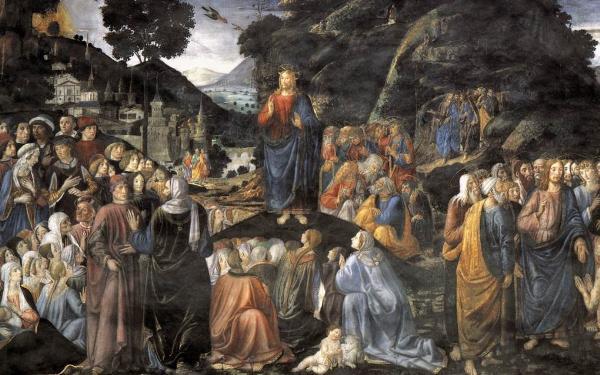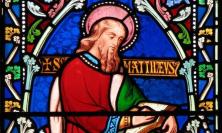This weekend – after Lent, Easter and a succession of solemnities – the Church’s Sunday liturgies return to Ordinary Time, with the reading of the final part of the Sermon on the Mount from Matthew’s gospel. Jack Mahoney SJ explores the significance of this famous discourse and its place in the moral teaching of Jesus.
The moral teaching of Jesus has inspired and challenged Christians and all men and women for centuries in ways which can never lose their relevance. This article concentrates on the central place and significance in the moral teaching of Jesus of the famous Sermon on the Mount as it is presented to us at the start of Jesus’ ministry.
The background in Matthew’s gospel
The Sermon on the Mount occurs in the Gospel of St Matthew, chapters 5-7, and is to be found nowhere else in the four Gospels, the nearest equivalent being what has become known as the Sermon on the Plain in St Luke’s Gospel, 6:17-49. Comparing these two passages of the Gospels, both in what they have in common and in how they differ, is a fascinating exercise which provides an excellent example of the inner structure of the New Testament and of how the four gospels we now have relate to one another. It is generally accepted that the Gospel of Mark is the earliest one which we possess, and that Matthew’s Gospel draws heavily on Mark, incorporating most of it while at the same time changing it and adding to it in numerous ways. These adaptations throw light on how and why Matthew’s gospel was composed, and how it reflects the Christian community from which it emerged, providing the reader with a window through which we can catch glimpses of the lives and daily concerns of that particular early body of Christian disciples.
The other gospel we know as St Luke’s also seems to draw heavily on the gospel of Mark for its own purposes, and this results in interesting passages in Matthew and Luke which are substantially similar, yet also differing, in their debt to Mark. In addition, Luke and Matthew contain other more or less common passages which are not to be found in Mark, and these are generally presumed to go back to another earlier document which we no longer possess, referred to by scholars as ‘Q’, the capital letter of the German word Quelle, or source.
Comparing Matthew’s Sermon on the Mount with Luke’s Sermon on the Plain leads to the conclusion that they both derive from the same conjectured source Q, which provided a collection of separate sayings and summaries of Jesus’ teaching. These sayings of the Lord had been remembered from different situations during his ministry and had been handed on by word of mouth before being put down in writing for the sake of new disciples. Such reported and written sayings originating with Jesus can be seen as a collection of bricks from which Luke and Matthew selected particular ones and often chiselled them into shape, using them to construct buildings with a purpose and a theological structure to fit their own conditions and to address their own concerns, as the German scholar Joachim Jeremias has suggested (see bibliography).
For one thing, the fact that one version of a particular group of sayings of Jesus is known as the Sermon on the Mount and the other as the Sermon on the Plain is not to be seen as referring to two distinct historical sermons delivered by Jesus, but to be making different theological points. In Luke the coming down of Jesus from the hill where he had been praying to a level place to address his disciples conveys the condescension of God in coming down to humanity and addressing it with the approachableness of Jesus which is typical of Luke’s gospel. By contrast, in Matthew the ascent of Jesus to a hillside to address his early followers is taken to ring a bell in the minds of many of the gospel’s early readers, and to recall how on an earlier famous occasion in the history of Israel a mountain was the setting for the people of God to assemble and receive from their leader the revealed law of God.
In fact, this suggestion of Jesus being presented to Matthew’s readers as a new Moses fits in very well with the overall view of Matthew’s gospel which is accepted today, as being an editorial construction out of the sayings of Jesus which was aimed at reflecting and addressing the special needs of a particular early Christian community which may have been located at Antioch in Syria and which included many adult converts from Judaism. In Matthew, as contrasted with the other three gospels, there are many indications of Jewish-Christian preoccupations, including regular references to the fulfilling of Old Testament prophecies, disputes about Jewish regulations concerning the observance of the Sabbath and ritual cleanliness, and references to pharisaic observances and scribal interpretations of the Mosaic law, including, notoriously, the ‘exceptive clause’ on divorce which is to be found only in Matthew’s gospel and twice at that (5:32; 19:9). It has even been suggested that Matthew’s community of Christians had been ‘excommunicated’ from Judaism by the rabbis after the fall of Jerusalem to Roman troops, and was seeking to defend itself as well as to establish its identity as the new, true Israel.
Within this Jewish-Christian context of Matthew’s gospel an interesting feature is that between the opening Infancy narrative and the closing Passion and Resurrection narratives the main body of the gospel divides significantly into five basic sections, each of them climaxing in a major sermon of Jesus. This would suggest to readers familiar with Judaism that the Matthaean evangelist was presenting them with a new, Christian Pentateuch (literally five volumes) superseding the earlier Pentateuch, or first five books, of the Old Testament. In other words, Jesus as a new Moses was presenting the new Israel with a new Torah, or divine law, from the mount, and the section containing this particular sermon of Jesus was being presented as ‘a symbolic Sinai’, in the phrase of the New Jerome Biblical Commentary (p. 639).
The proposed division of the gospel is as follows, every section referring in one way or another to the central theme of Matthew’s gospel, the kingdom of God:
1. Inaugurating the Kingdom of God (3:1-7.29) >> The Sermon on the Mount (5-7)
2. Spreading the Kingdom (8:1-10:42) >> The Missionary Sermon (10:1-42)
3. The Nature of the Kingdom (11:2-13.53) >> The Parables of the Kingdom (13:1-53)
4. The Community of the Kingdom (13:54-18:35) >> The Sermon on Church order (18:1-35)
5. The Fulfilling of the Kingdom (19:2-25:46) >> The Apocalyptic Discourse (23:1-25:46)
The role of the sermon
These results of modern biblical scholarship provide a remarkably rich theological context in which we can understand and appreciate the role and the teaching contents of the Sermon on the Mount. As Pope Benedict observed in his recent study of Jesus (p. 68), ‘The Sermon on the Mount is the new Torah brought by Jesus... as the new Moses whose words constitute the definitive Torah.’
In addition, the sermon can also be understood within the new covenant which God was setting up with the new Israel as the opening address of Jesus inaugurating the kingdom of God. As the leader of God’s new people he was spelling out the message of the dramatic miracles and healings which he had been performing earlier in Matthew’s gospel, that the kingly power of God was now beginning to be made manifest in the activities and teaching of Jesus. As Matthew summarised it, ‘Jesus went throughout Galilee, teaching in their synagogues and proclaiming the good news of the kingdom and curing every disease and every sickness among the people’ (Mt 4:23). The sermon which closed this opening section of Jesus’ gospel ministry in Matthew shows us Jesus now describing and explaining what life would be like for his followers in the kingdom, as it would describe and confirm to subsequent generations of new Christians, beginning with the Matthaean community, what being a disciple of Jesus would now regularly involve for them.
This dual role of the Sermon on the Mount in the time of Jesus and later in the life of the Church was well brought out by Pope Benedict (p. 101) when he described how, “In the Sermon on the Mount Jesus speaks to his people, to Israel, as to the first bearer of the promise. But in giving them the new Torah, he opens them up, in order to bring to birth a great new family of God drawn from Israel and the Gentiles. Matthew wrote his Gospel for Jewish Christians and, more widely, for the Jewish world, in order to renew this great impulse that Jesus had initiated.”
Viewing the Sermon on the Mount thus as a preview of Christian living within the kingdom of God helps us to uncover its inner structure and thus to recognise the whole discourse as being carefully fashioned from previous sayings of Jesus to provide a detailed exposition of his key statement which forms, as it were, the text of the sermon: ‘I tell you, unless your righteousness exceeds that of the scribes and Pharisees, you will never enter the kingdom of heaven (Mt 5:20). The sermon is an unpacking of what the true relationship of Christians to God must entail, as contrasted with the ways in which their opponents, the scribes and Pharisees, are (polemically) portrayed as behaving. As with Paul in his letter to the Romans, the famous but elusive biblical term ‘righteousness’, or dikaiosune (based on the Greek term dike, or justice), attempts in the Sermon on the Mount to capture how a forgiving God takes the initiative in relating to us and how we in turn should correspondingly respond from our hearts to this generous heavenly father.
We can further recognise the purpose of the sermon in the early Christian community by viewing it within the nature of the gospel of Matthew in which it occurs, whose ‘primary intent’ according to the New Jerome Biblical Commentary (631) ‘was to write a handbook for church leaders to assist them in preaching, teaching, worship, mission and polemic.’ C. H. Dodd also sees a practical purpose for the sermon in identifying it, following as it does immediately on the accounts of the wonder works of Jesus which were introducing the kingdom of God, as an instance of that early Christian practical teaching, or didache,which Dodd suggested regularly complemented Christian preaching or proclamation (kerygma) of the gospel. In this way the sermon falls into the type of document to which Acts 2:42 refers in describing how the early Christian converts “devoted themselves to the apostles’ teaching.” In fact, the sermon itself concludes with the observation (Mt 7:28) that “the crowds were astounded at his teaching (didache)” – a term which is evidently intended to be echoed at the end of Matthew’s gospel (28:20) in the final charge of the risen Jesus to his apostles to go and ‘teach’ all nations ‘to obey everything that I have commanded you.’ On the sermon itself Jeremias has a more specific suggestion that it had formed an early Christian catechism to be used in preparing adult converts for their new life in the community of believers.
Whatever be its ecclesial provenance, from its content and inner structure Matthew’s Sermon on the Mount is evidently aimed at presenting an authoritative portrait of Christian discipleship. After a description of Jesus’ introductory healing ministry the scene is set in his ascending the hill and solemnly sitting down to address his disciples and the crowd of interested bystanders. In the opening section of his address he sketches in the Beatitudes a portrait of his followers and then commissions them, exhorting them to show ‘greater rightness’ than that of the scribes and the Pharisees. The main body of the sermon can then be identified as containing three sections to do with this relationship with God: one contrasting traditional Jewish moral teaching (of the scribes?) with new moral principles enunciated by Jesus; a second on the practice of ‘righteousness,’ (Mt 6), religious and devotional practices as performed by the Pharisees, to be rejected now in favour of Christian practices; and a third section, less clearly composed than the previous two, which can be read as describing the true righteousness which is henceforth to be found and practised in the kingdom of God, and the complete trust and single-minded devotion which God’s sons and daughters are invited to manifest to their loving and protecting Father. The first thing that needs to be done, Jesus concludes here (6:33), is to seek the kingdom of God and its (or his) righteousness, and everything else will come later. There follow then some closing warnings on the seriousness of the situation and a parable aimed at emphasising the need not just to listen to the words of Jesus but also to obey them. In conclusion we are told, “the crowds were astonished at his teaching, for he taught them as one having authority, and not as their scribes” (7:28-29).
Conclusion
From what we have seen, the Sermon on the Mount is intended to identify the ways in which the followers of Jesus should behave in living a life of acceptance of God’s gracious invitation to enter the kingdom of heaven.
Jack Mahoney SJ is Emeritus Professor of Moral and Social Theology in the University of London, and currently a staff member of the Mount Street Jesuit Centre, London. He has written widely in various branches of Christian and philosophical ethics. His latest book is The Challenge of Human Rights. Origin, Developments and Significance, Oxford, Blackwell Publications, 2007.
![]() The Challenge of Human Rights: Origin, Developments and Significance by Jack Mahoney SJ
The Challenge of Human Rights: Origin, Developments and Significance by Jack Mahoney SJ
![]() ‘Living the Sermon on the Mount’ by Jack Mahoney SJ
‘Living the Sermon on the Mount’ by Jack Mahoney SJ
![]() ‘The Shape of the Sermon on the Mount’ by Jack Mahoney SJ
‘The Shape of the Sermon on the Mount’ by Jack Mahoney SJ






